

Copyright Overview Written Explanation. Overview: Copyright Basics. (Purdue University is a well-renown institution of higher learning.) What is copyright?
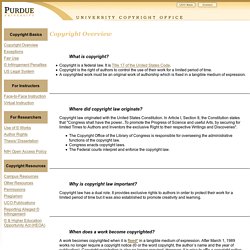
Copyright is a federal law. It is Title 17 of the United States Code. Copyright is the right of authors to control the use of their work for a limited period of time. A copyrighted work must be an original work of authorship which is fixed in a tangible medium of expression. Where did copyright law originate? Copyright law originated with the United States Constitution.
Overivew: US Copyright Office. (This is the office of public record for copyright registration and deposit of copyright material.) Overview: Copyright and Fair Use Animation Video. (Copyright information is broken down in a way that students of any age will understand.) Copyright Print Work Written Explanation. Print Work: How to use other's writing in your own. (Advice for writers. Essay writers will benefit tremendously from this information.) I’ve been researching what the best practices are these days for copyright, and I’ll be writing about them in articles soon.

But one area of copyright is really difficult to understand for most publishers, and for bloggers too for that matter. And that is: What constitutes “fair use”? To answer this question I’m very fortunate to have an expert to guide us. Today’s guest post is by Attorney David L. Amkraut, and you can find out more about David at the end of the article. Print Work: When to Get Permission, and When You Don't Need To.
Print Works: Use of Copyright Materials & Fair Use Materials. Sooner or later, almost all writers quote or closely paraphrase what others have written.
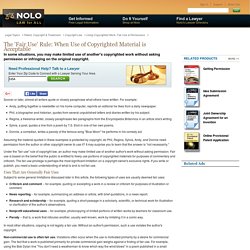
For example: Andy, putting together a newsletter on his home computer, reprints an editorial he likes from a daily newspaper.Phil, a biographer and historian, quotes from several unpublished letters and diaries written by his subject.Regina, a freelance writer, closely paraphrases two paragraphs from the Encyclopedia Britannica in an article she's writing.Sylvia, a poet, quotes a line from a poem by T.S. Eliot in one of her own poems.Donnie, a comedian, writes a parody of the famous song "Blue Moon" he performs in his comedy act. Copyright Images Written Explanation. Images: Using online images. (Social Media Examiner is a website that teaches people how to create websites and produce content.)
You’ve heard the adage that a picture is worth a thousand words, but when that picture is protected by copyright, the picture is only worth three words: cease and desist.

OK, that’s kind of a lawyer joke. But it illustrates how protective people are about finding their images used online without permission. Copyright laws were established not to give the author the right to deny their work to other people, but instead to encourage its creation. Article I, Section 8, clause 8, of the United States Constitution states the purpose of copyright laws is “to promote the Progress of Science and useful Arts, by securing for limited times to Authors and Inventors the exclusive Right to their respective Writings and Discoveries.”
It’s a delicate balance between the rights of the creator and the public’s interest. The Best Ways to Be Sure You're Legally Using Online Photos. How to Use Photos without Violating Copyright Laws. Originally posted 2012-10-05 13:02:53.

Visual media has become instrumental in designing a website or posting in social media sites such as Pinterest and Facebook. But if you don’t own the photos you plan on using, how do you go about getting the photos your site needs? Grabbing pictures from Google images, off of other websites, or even assuming that you have the rights to photos of yourself or your business despite that it was taken by someone else are all common mistakes that violate copyright law, and if charged, you can be faced with damages of up to $150,000 per image. Copyright Video Written Explanation. Deciding if Video is Fair Use. If your video was blocked for copyright reasons, either by an automated Content ID match or by a DMCA notice, you will have to decide if your video falls under the "fair use" exception to copyright, or if you had some other kind of authorization to use copyright content (such as getting permission from the copyright holder).
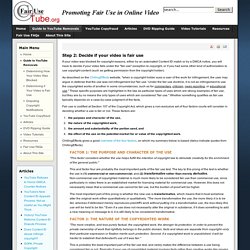
As described on the ChillingEffects website, "when a copyright holder sues a user of the work for infringement, the user may argue in defense that the use was not infringement but 'fair use.' Under the fair use doctrine, it is not an infringement to use the copyrighted works of another in some circumstances, such as for commentary, criticism, news reporting, or educational use. " These specific purposes are highlighted in the law as particular types of uses which are strong examples of fair use, but they are by no means the only types of uses which are considered "fair use. " This and factor four are probably the most important parts of the fair use test. The Complete Guide To Fair Use & YouTube. When it comes to YouTube, copyright law can be a video creator’s biggest nightmare.

Can you use footage shot by someone else? Can you cover or parody a song by a popular artist? When is it fair use to include copyrighted material in your YouTube video and when is it not? How To Legally Use Copyrighted Music, Games, and Movies on YouTube. Copyright Music Written Explanation. How To Legally Use Copyrighted Background Music in Video. The steps you need to take if you want to use commercial music in your marketing or corporate video without violating copyrights Either if you make marketing videos for your own small business or create content for your clients, you may find yourself in need of legal background music.
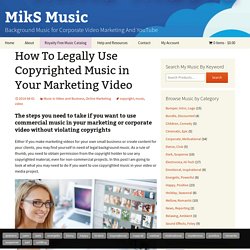
Copyright issues when using music in videos. Welcome to the digital age!
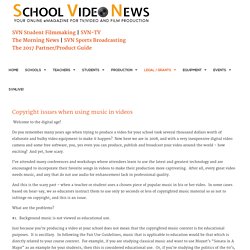
Do you remember many years ago when trying to produce a video for your school took several thousand dollars worth of elaborate and bulky video equipment to make it happen? Now here we are in 2008, and with a very inexpensive digital video camera and some free software, you, yes even you can produce, publish and broadcast your video around the world – how exciting! And yet, how scary. I’ve attended many conferences and workshops where attendees learn to use the latest and greatest technology and are encouraged to incorporate their favorite songs in videos to make their production more captivating. After all, every great video needs music, and any that do not use audio for enhancement lack in professional quality.
YouTube launches library of free music that anyone can use. YouTube includes a number of simple production tools to help filmmakers improve their projects, but today it's launching one that could be huge for the low- or no-budget shooter: a library of completely free music that can be used in any video — even ones that don't end up on YouTube.
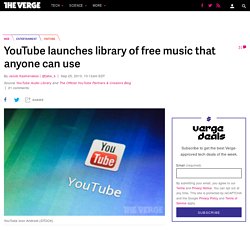
The YouTube Audio Library is launching with 150 tracks in genres spanning from funky dance and electronic to sappy country tunes, all of which can be streamed and downloaded as 320kbps MP3 files. You might expect them all to be corny jams or forgettable muzak — and some certainly are — but there are absolutely some gems within the collection that do a great job representing their genre without feeling like a knockoff product. Though the cost of great cameras for filmmaking has been going down, there are still plenty of areas of production that can bump up costs, like editing software, camera rigs, and music. Though there are troves of license-free music on the web, their quality is unsurprisingly mixed. Copyright Fair Use. Copyright Overview by Rich Stim. In its most general sense, a fair use is any copying of copyrighted material done for a limited and “transformative” purpose, such as to comment upon, criticize, or parody a copyrighted work.
Such uses can be done without permission from the copyright owner. In other words, fair use is a defense against a claim of copyright infringement. If your use qualifies as a fair use, then it would not be considered an infringement. So what is a “transformative” use? If this definition seems ambiguous or vague, be aware that millions of dollars in legal fees have been spent attempting to define what qualifies as a fair use. Most fair use analysis falls into two categories: (1) commentary and criticism, or (2) parody. Commentary and Criticism. Columbia University Libraries. Copyright 9 23 08. Copyright Public Domain Written Explanation.
Public Domain Frequently Asked Questions. What is the public domain? Public domain works are not restricted by copyright and do not require a license or fee to use. Public domain status allows the user unrestricted access and unlimited creativity! There are three main categories of public domain works: Works that automatically enter the public domain upon creation, because they are not copyrightable: Titles, names, short phrases and slogans, familiar symbols, numbersIdeas and facts (e.g., the date of the Gettysburg Address)Processes and systemsGovernment works and documentsWorks that have been assigned to the public domain by their creatorsWorks that have entered the public domain because the copyright on them has expired.
A working definition of public domain. What we’re talking about here is a particular definition of public domain, having to do with the copyright status of creative works. (This tutorial isn’t about the land owned by the US government, which is also referred to public domain.) Many people think the definition of public domain is “freely available.” They believe that creative works (including articles, images, videos, music, software) available on the Internet are fair game because they’re in the public domain. The fact is, they’re wrong. Even though something is freely available and easy to copy, that doesn’t mean it’s in the public domain.
Put simply, the public domain consists of works that aren’t protected by copyright or by other legal means. Their copyrights have expired; or the copyright owner didn’t follow certain required formalities (so they didn’t get a valid copyright); or the works weren’t eligible for copyright in the first place; or their creators dedicated them to the public domain.
What facts do you need? Public Domain Day Frequently Asked Questions. What is the “public domain”? The public domain is the realm of material — ideas, images, sounds, discoveries, facts, texts — that is unprotected by intellectual property rights and free for all to use or build upon. It includes our collective cultural and scientific heritage, and the raw materials for future expression, research, democratic dialogue and education. back to top Is the public domain just material that you can use without paying for it? No. What kinds of things are in the public domain? Copyright Creative Commons. About - Creative Commons. Creative Commons is a nonprofit organization that helps overcome legal obstacles to the sharing of knowledge and creativity to address the world’s pressing challenges.
In order to achieve our mission, we: Learn more about Creative Commons through our collection of public reports and financials. For information about CC’s funding agreements, please see our Contributions Policy. Certain states require written disclosures for nonprofit organizations soliciting contributions. CC’s individual state disclosures are available here. What is Creative Commons? 5 Frequently Asked Questions. Creative Commons - YouTube Help.